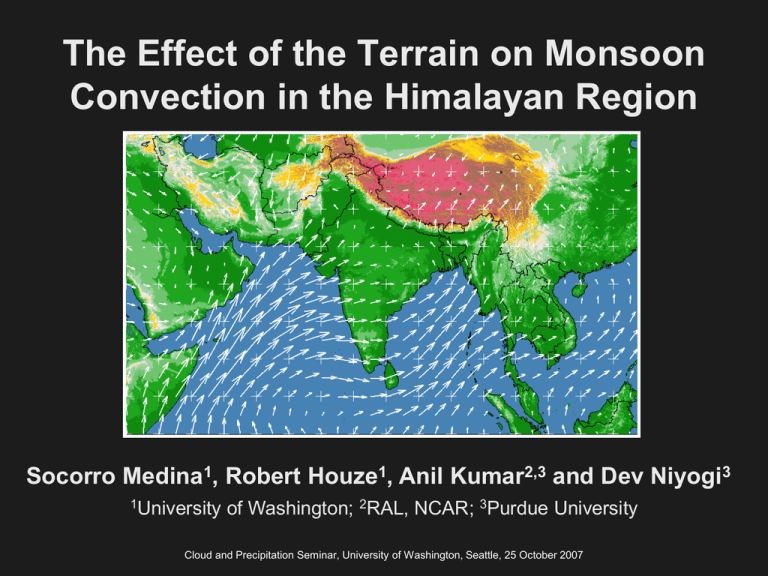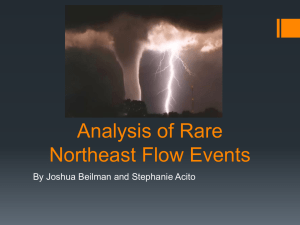The Effect of the Terrain on Monsoon Socorro Medina , Robert Houze
advertisement

The Effect of the Terrain on Monsoon Convection in the Himalayan Region Socorro Medina1, Robert Houze1, Anil Kumar2,3 and Dev Niyogi3 1University of Washington; 2RAL, NCAR; 3Purdue University Cloud and Precipitation Seminar, University of Washington, Seattle, 25 October 2007 Precipitation distribution in relation to terrain Orography (km) Jun-Aug precipitation (mm/month) (Climatology from TRMM-PR data from 1997-2004) Arabian Sea Xie et al. (2006) Bay of Bengal MOTIVATION – MONSOON 2007 (Jun-Aug) Precipitation (mm) Anomaly (%) MONSOON CONVECTION IN THE HIMALAYAN REGION – Three part study 1 Houze, Wilton, and Smull (2007) – 3D structure of intense storms and their distribution in relation to topography and surrounding oceans 2 Ulrike Romatschke (Ulli) – Is extending Houze et al. (2007) study Cloud and Precipitation Seminar Nov 15th 3 Analyze numerical simulations to investigate the detailed role of the terrain – preliminary results MONSOON CONVECTION IN THE HIMALAYAN REGION – Three part study 1 Houze, Wilton, and Smull (2007) – 3D structure of intense storms and their distribution in relation to topography and surrounding oceans 2 Ulrike Romatschke (Ulli) – Is extending Houze et al. (2007) study Cloud and Precipitation Seminar Nov 15th 3 Analyze numerical simulations to investigate the detailed role of the terrain – preliminary results Houze, Wilton, and Smull (2007) study • Data from Precipitation Radar (PR) on the Tropical Rainfall Measuring Mission (TRMM) satellite (June-September 2002/2003) • Found contiguous radar echoes that exceeded some size threshold • Analyzed separately convective and stratiform radar echoes Convective and stratiform radar reflectivity echoes Horizontal cross-section Vertical cross-section convective echo Vertical cross-section stratiform echo Houze (1997) Results of Houze et al. (2007): Western Central Deep Intense Convective Cores 40 dBZ echo > 10 km in height Wide Intense Convective Cores 40 dBZ echo > 1000 km2 area Broad Stratiform Echo > 50,000 km2 Eastern Example of Deep Intense Convective Core (40 dbz echo >10 km in height) Example: Reflectivity at 0900 UTC 14 Jun 2002 Delhi sounding 00 UTC 14 Jun 2002 Houze et al. (2007) 10 m winds reanalysis at 1200 UTC 14 Jun 2002 Orography Carlson et al. 1983 Results of Houze et al. (2007): Deep Intense Convective Cores 40 dBZ echo > 10 km in height Western Central Wide Intense Convective Cores 40 dBZ echo > 1000 km2 area Broad Stratiform Echo stratiform echo > 50,000 km2 Eastern Example of Wide Intense Convective Core (40 dbz echo >1000 km2 in area) Example: Reflectivity at 2208 UTC 3 Sep 2003 Houze et al. (2007) Results of Houze et al. (2007): Deep Intense Convective Cores 40 dBZ echo > 10 km in height Wide Intense Convective Cores 40 dBZ echo > 1000 km2 area Western Central Broad Stratiform Echo stratiform echo > 50,000 km2 Eastern Example of Broad Stratiform Echo (>50,000 km2 in area) 00 UTC 11 Aug 2002 Tengchong sounding Example: Infrared satellite temperature and reflectivity at ~03 UTC 11 Aug 2002 10 m winds reanalysis at 00 UTC 11 Aug 2002 Houze et al. (2007) MONSOON CONVECTION IN THE HIMALAYAN REGION – Three part study 1 Houze, Wilton, and Smull (2007) – 3D structure of intense storms and their distribution in relation to topography and surrounding oceans 2 Ulrike Romatschke (Ulli) – Is extending Houze et al. (2007) study Cloud and Precipitation Seminar Nov 15th 3 Analyze numerical simulations to investigate the detailed role of the terrain – preliminary results MONSOON CONVECTION IN THE HIMALAYAN REGION – Three part study 1 Houze, Wilton, and Smull (2007) – 3D structure of intense storms and their distribution in relation to topography and surrounding oceans 2 Ulrike Romatschke (Ulli) – Is extending Houze et al. (2007) study Cloud and Precipitation Seminar Nov 15th 3 Analyze numerical simulations to investigate the detailed role of the terrain – preliminary results OBJECTIVES • Evaluate if high-resolution models can predict the structures observed by Houze et al. (2007) • Test the ideas put forward in that study: – Investigate why the intense convection is often observed over the foothills – Analyze the relative roles of orography and synoptics in systems observed in association with Bay of Bengal depressions NUMERICAL SIMULATIONS • Weather Research and Forecasting (WRF v2.1.1) model (runs conducted by Anil Kumar, NCAR/Purdue University) – NCEP Reanalysis used as initial and boundary conditions (6 hourly) – Bulk microphysical parameterization: WRF Single-Moment with 6 water substances • Isolated deep convective system: dx1=9 km; dx2 = 3 km (14 Jun 2002) Simulation couldn’t capture system • Wide intense convective system (3 Sep 2003) • Broad stratiform system (11 Aug 2002) • HYSPLIT model trajectories using NCEP reanalysis (http://www.arl.noaa.gov/ready/hysplit4.html) Wide convective system simulation Time: 18-23 UTC 3 Sep 2003 (0030-0530 LST) Terrain and accumulated precipitation (mm) Domain 1: dx = 9 km India Domain 2: dx = 3 km Wide convective system Evaluation at 2130 UTC 03 Sep 2003 (0400 LST, t=3.5 h) Observations WRF-simulation Infrared satellite temperature (shaded, K) and low-resolution terrain (black contours, km) Cloud top temperature (shaded, K) and terrain (black contours, m) Pakistan India Pakistan India Wide convective system Evaluation at 2130 UTC 03 Sep 2003 (0400 LST, t=3.5 h) Observations WRF-simulation Infrared satellite temperature (shaded, K) and low-resolution terrain (black contours, km) Cloud top temperature (shaded, K) and terrain (black contours, m) Pakistan India Pakistan India Wide convective system Evaluation at 2230 UTC 03 Sep 2003 (0500 LST, t=4.5 h) Observations WRF-simulation Infrared satellite temperature (shaded, K) and low-resolution terrain (black contours, km) Cloud top temperature (shaded, K) and terrain (black contours, m) Pakistan India Pakistan India Wide convective system Evaluation at 2300 UTC 03 Sep 2003 (0530 LST, t=5.0 h) Observations WRF-simulation Infrared satellite temperature (shaded, K) and low-resolution terrain (black contours, km) Cloud top temperature (shaded, K) and terrain (black contours, m) Pakistan India Pakistan India Wide convective system – Evaluation of reflectivity (22 UTC 3 Sep) Observations WRF-simulation Wide convective system – Hypotheses testing HYPOTHESIS - Low-level moist southwesterly flow was capped by dry air flowing off the high Tibetan Plateau or the Afghan mountains Surface water vapor mixing ratio (g/kg) and winds Backward trajectories (HYSPLIT/NCEP) 0.5 km 2.5 km http://www.arl.noaa.gov/ready/hysplit4.html Wide convective system – Hypotheses testing HYPOTHESIS - Low-level moist southwesterly flow was capped by dry air flowing off the Afghan mountains Surface dew point depression (°C) Wide convective system – Hypotheses testing HYPOTHESIS - Low-level moist southwesterly flow was capped by dry air flowing off the Afghan mountains Soundings at 1800 UTC Dry side Moist side Wide convective system – Hypotheses testing HYPOTHESIS - Convection started where the potentially unstable column was subjected to orographic lifting CAPE (J/kg) 3000 2000 1000 Wide convective system – Hypotheses testing HYPOTHESIS - Convection started where the potentially unstable column was subjected to orographic lifting Surface dew point depression (°C) and vertically integrated mixing ratio of precipitating hydrometeors (mm) at 1925 UTC (t=1.25 h) Wide convective system – Hypotheses testing HYPOTHESIS - Convection started where the potentially unstable column was subjected to orographic lifting Mixing ratio (g/kg) of water vapor (shaded), cloud hydrometeors (dark red) and precipitating hydrometeors (dark blue) at 1815 UTC 20 18 16 12 8 4 Wide convective system – Hypotheses testing HYPOTHESIS - Convection started where the potentially unstable column was subjected to orographic lifting Mixing ratio (g/kg) of water vapor (shaded), cloud hydrometeors (dark red) and precipitating hydrometeors (dark blue) at 1830 UTC 20 18 16 12 8 4 Wide convective system – Hypotheses testing HYPOTHESIS - Convection started where the potentially unstable column was subjected to orographic lifting Mixing ratio (g/kg) of water vapor (shaded), cloud hydrometeors (dark red) and precipitating hydrometeors (dark blue) at 1845 UTC 20 18 16 12 8 4 Wide convective system – Hypotheses testing HYPOTHESIS - Convection started where the potentially unstable column was subjected to orographic lifting Mixing ratio (g/kg) of water vapor (shaded), cloud hydrometeors (dark red) and precipitating hydrometeors (dark blue) at 1900 UTC 20 18 16 12 8 4 Wide convective system – Role of the NW concave indentation of the terrain ‘Idealized’ (highly smoothed) low-level variables Dew point depression > 10°C CAPE > 1800 J/kg CIN > 150 J/kg Temperature > 31°C Mixing ratio > 20 g/kg Relative Humidity (% ) - Shaded CONCLUSIONS Convective systems • High-resolution model was able to predict the observed structures (if the system is wide enough AND the model has enough resolution) • In Wide Intense Convective storm, the terrain appears to play three main roles: – The NW concave indentation of the terrain increases the existing humidity gradients – Elevated layer of dry, warm air originates over the Afghan mountains and caps the moist low-level flow allows buoyancy to build up – The convection is triggered at the small features of terrain (h<0.5 km): orographic lifting, convergence or both Broad stratiform system simulation Time: 12 UTC 10 Aug – 03 UTC 11 Aug 2003 (1830-0930 LST) Terrain and accumulated precipitation (mm) Domain 1: dx = 27 km Domain 2: dx = 9 km Broad stratiform system – Evaluation of low-levels winds at 00 UTC 11 Aug 2002 Observations 10 m winds and wind speed (m/s) WRF-simulation Surface winds and wind speed (m/s) and terrain (red contours) Broad stratiform system – Evaluation of IR temperature and reflectivity Observations WRF-simulation Broad stratiform system – Sounding at Tengchong at 00 UTC 11 Aug 2002 Observations WRF-simulation Broad stratiform system – Role of the Bay of Bengal Depression ‘Idealized’ (highly smoothed) low-level variables Rainrate > 5 mm/hr Mixing ratio > 21 g/kg LOW Wind speed > 5m/s SLP PRELIMINARY CONCLUSIONS – Broad stratiform system • The high-resolution model was able to predict the observed structures • The Bay of Bengal depression provides lowlevel moisture and cross-barrier flow • Low-level flow channeled between individual ranges and impinges into the NE indentation of the Himalayas Concluding remark…. Schultz et al. 2000 “In diagnosing precipitation processes, assessing the mechanism for forcing ascent should be the primary concern. The degree of instability… merely modulates the response to the forcing” Wide convective system – Role of the NW concave indentation of the terrain ‘Idealized’ (highly smoothed) low-level variables Dew point depression > 10°C CAPE > 1800 J/kg CIN > 150 J/kg Temperature > 31°C Mixing ratio > 20 g/kg Equivalent potential temperature > 364 K Wide convective system – Hypotheses testing HYPOTHESIS - Convection started where the potentially unstable column was subjected to orographic lifting CAPE (for parcel with max theta_e, J/kg) CIN (for parcel with max theta_e, J/kg) Wide convective system Evaluation at 1830 UTC 03 Sep 2003 Observations WRF-simulation Infrared satellite temperature (shaded, K) and low-resolution terrain (black contours, km) Cloud top temperature (shaded, K) and terrain (black contours, m) Pakistan India Pakistan India Wide convective system Evaluation at 1900 UTC 03 Sep 2003 Observations WRF-simulation Infrared satellite temperature (shaded, K) and low-resolution terrain (black contours, km) Cloud top temperature (shaded, K) and terrain (black contours, m) Pakistan India Pakistan India Wide convective system Evaluation at 2100 UTC 03 Sep 2003 (XXX LST, t=X h) Observations WRF-simulation Infrared satellite temperature (shaded, K) and low-resolution terrain (black contours, km) Cloud top temperature (shaded, K) and terrain (black contours, m) Pakistan India Pakistan India Broad stratiform system simulation Terrain and accumulated precipitation (mm) Broad stratiform system – Hypotheses testing HYPOTHESIS – The flow over the terrain enhances the mesoscale precipitation areas Vertically integrated precipitating mixing ratio over 15 h (mm) Broad stratiform system – Hypotheses testing HYPOTHESIS – The flow over the terrain enhances the mesoscale precipitation areas Cloud water mixing ratio and vertical velocity Stratiform case Broad stratiform system – Evaluation of 200 mb winds at 00 UTC 11 Aug 2002 Observations wind speed (m/s) WRF-simulation wind speed (m/s) and terrain (red contours) Wide convective system – Hypotheses testing HYPOTHESIS - Convection started where the potentially unstable column was subjected to orographic lifting Mixing ratio (g/kg) of water vapor (shaded), cloud hydrometeors (dark red) and precipitating hydrometeors (dark blue) at 1800 UTC 20 18 16 12 8 4
